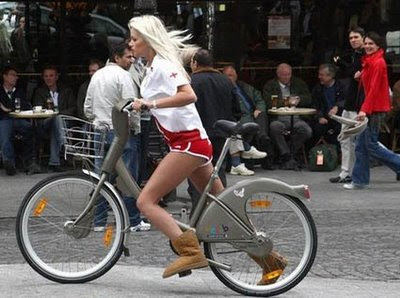I met Charlie in his Government Center office a couple of weeks ago. What I first noticed about him was his expression, which toggled between a smile and a laugh. He talked easily and candidly, and he was a good listener (a plus for a chatterbox like me). What set his office apart from other work spaces were the two bike racks resting against a wall. One, called an inverted "U" rack, looked like a bent piece of black tubing, and the other one was green and was supposed to resemble flowers, but it looked like lollipops to me.
Charlie is serious about biking. To set the county's cycling priorities, he works not only with his colleagues but also with members of FABB, Fairfax's bicycle advocacy group. That's Charlie, on the right, at a FABB meeting. (Thanks to Bikes@Vienna blog for this photo.)
He said that FABB's priorities pretty much match the county's, and currently, installing bike racks and bike lockers at transit stations is at or near the top of everyone's list. That makes sense. Fairfax County, like all of Northern Virginia, has a vicious traffic problem and getting people on bikes may pull some cars off the road. A December 2008 article in Forbes claims that the greater DC metropolitan region is the worst part of the country for small-city commutes, and I've heard repeatedly that only Los Angeles commuters spend more time in their cars than their DC counterparts. That's a lot of cars and a lot of opportunity for cyclists to be injured and bikes to be damaged or stolen. The double risk of theft and flesh wounds is enough to send would-be bike commuters back to the gas pumps.
To protect bikes, Fairfax County has installed bike racks at VRE parking garages, park-and-ride lots, and other transit stations. 150 more sites are due to receive racks. Two park-and-ride lots (in Reston and in Herndon) have bike lockers, and 50 more lockers are on their way.

A bike locker is like a small square self-storage space; the bikes are completely contained in the lockers so there's no exposure to the natural elements (inclement weather) or the bad elements (thieves and vandals). The annual rental fee for one locker is $60/year. Fairfax County has also equipped its Connector buses with front-mounted bike racks that carry two bikes. Charlie said that some racks will be replaced with ones that can carry three.

To ensure safety on the roads, Fairfax County works with the Virginia Department of Transportation (VDOT) to identify streets that can accommodate bike lanes. They also collaborate on painting the necessary stripes and symbols and providing signage. I am a poor judge of anything quantitative (prices, weight, age, distance, altitude, carbon-dating), but it makes me feel cool to know this and I'll share it with you: a normal travel lane is 12 feet wide with a 2-foot gutter pan - I'm trying to picture it as I type. A bike lane eats up about 2 feet of width on each side of the road. So, when identifying potential bike lane routes, Charlie starts with the easy roads - those that are wide and smooth. Currently, 40 segments are under consideration.
Charlie's budget is about $500,000/year. It seemed to me a paltry sum, given the entire county budget, but I guess in these lean times, I should be grateful that Fairfax has set aside any money at all for bike-related projects.
If you want more information about Fairfax County's bike program, click here. And the next time you ride on a well-marked ample bike lane, chances are, it's Charlie's.
















